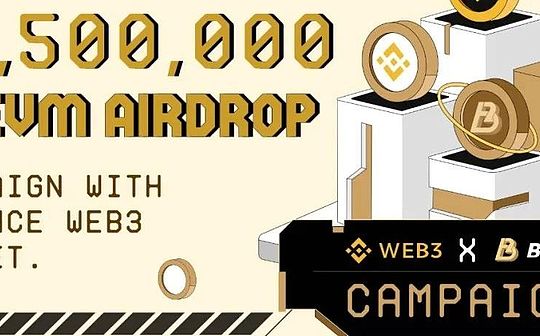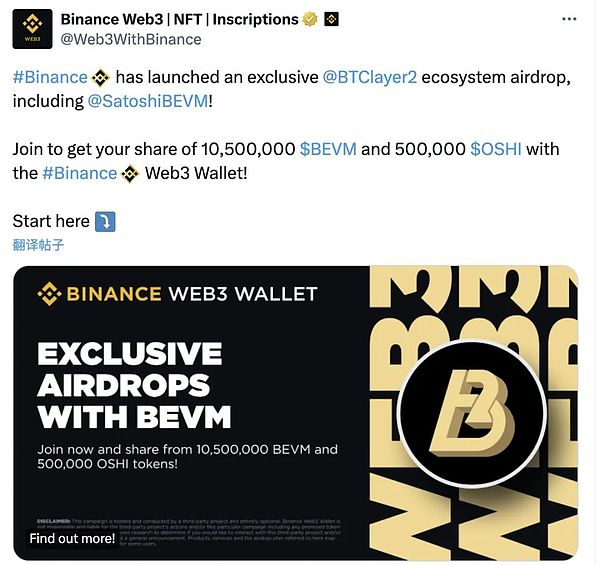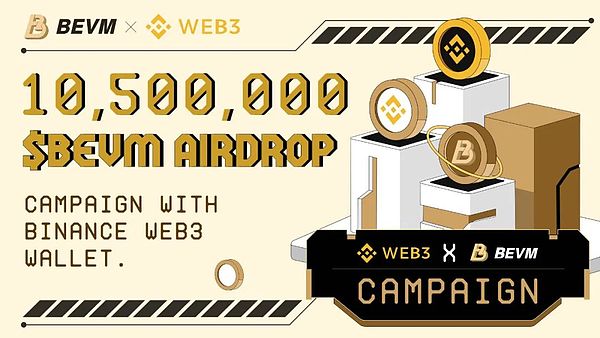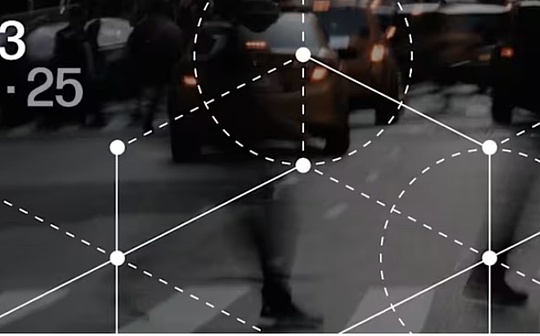
On April 5, Binance Web3 Wallet and Bitcoin Layer2 project BEVM jointly launched an airdrop activity, and BEVM, which has not yet issued tokens, also explicitly allocated 0.5% of its total token supply (10.5 million tokens) for this.Airdrop.

It should be noted that even though there are so many “Bitcoin L2” projects on the market, Binance has not reached a cooperation with any project before, so why can BEVM reach a cooperation with Binance?What kind of grass snake gray line is possible?
Binance “needs” Bitcoin L2
We only need to review the competitive landscape of CEX around the Bitcoin ecosystem since 2023, and we will understand the strategic significance of BTC L2 in 2024 in competition in CEX’s Web3 wallet and other dimensions.
As we all know, OKX in 2023 is undoubtedly the biggest winner in the Bitcoin ecological wave, from cooperating with UniSat Wallet to co-constructing the BRC-20 industry standard, to being the first to support BRC20 inscriptions and BTC NFT transactions and pledges, launching the Bitcoin ecological standard BRC20-S,Components such as inscription tools are extremely fast in layout, and in the earliest stages there were waves of market demand and user traffic.
This also helped it to be the first to support BRC20 inscriptions and BTC NFT transactions and pledges. The OKX Web3 wallet, which has shined in 2023. It has not only become a must-have tool for many industry users, but many users have even begun to use OKX Web3 wallet to replace MetaMask.The veteran wallet players have become the most eye-catching new star in the crypto wallet track.
At the same time, as the absolute leader of the exchange, Binance is significantly behind OKX in terms of the layout of Web3 wallet and Bitcoin ecosystem, resulting in a large amount of traffic surrounding the Bitcoin ecosystem being seized, missing the potential huge Bitcoin ecosystem.Market cake.Therefore, since the end of last year, the construction layout of Binance Web3 wallet and Bitcoin ecosystem has been accelerating, and priority has been continuously raised.
As the advantages of competitors such as OKX continue to stabilize, for Binance, how to find a breakthrough and overtake the Bitcoin ecosystem will naturally become a core topic in 2024.
In all narratives, infrastructure projects often play the role of “water seller”, and generally become a need among the urgent needs as the track continues to be built. Therefore, for Binance, supporting infrastructure projects BTC L2,It’s a good method and strategy:
By supporting a leading Bitcoin L2 player as a tool, it attracts and carries the user traffic and community attention of the Bitcoin ecosystem, and opens up the pipeline for market capital influx, thereby achieving overtaking on the OKX Bitcoin ecosystem layout.
If we look at it from this perspective, Binance’s cooperation with BEVM may be the touchstone.In addition, since top exchanges often have huge amounts of Web3 resources, whether it is financial support or product windows, it can give Bitcoin L2 projects a great catalytic effect and completely release its liquidity. For example, OKX has already laid out Bitcoin earlyL2 project B² Network and Bitcoin eco-project Bitmap Tech (formerly Recursiverse).
Therefore, for Binance, timely supporting its Bitcoin L2 team is the key to the long-term competition with OKX in the Bitcoin ecosystem in 2024. This will greatly expand the size and gameplay of the entire Bitcoin L2 track, which may become aOne of the catalysts for a new round of market conditions.
Why BEVM?
Overall, this is also the key to the cooperation between Binance and BEVM – accelerate the embrace of Bitcoin L2 ecosystem through BEVM, which is a hot land that needs to be built, further expand Binance’s leading position in the new Bitcoin narrative and a new wave ofDApps, new users and ultimately the growth of Bitcoin ecosystem TVL.
Of course, in addition to BEVM, there are many other “Bitcoin L2” projects on the market. Why did Binance choose BEVM?
First of all, from a certain perspective, BEVM has always been regarded as a “technical veteran” of the Bitcoin ecosystem that has been tested by time and market.Less well known is that the BEVM team was founded in 2017, and founder Gavin participated in the research and development of the central bank’s digital currency (DCEP) in 2016 and wrote the first viable CBDC demo based on Bitcoin and Ethereum blockchain.
By 2017, the underlying code of the well-known public chain Biyuan chain was completed from 0 to 1, and then left Biyuan chain to create BEVM at the end of 2017.
Among them, he launched the Polkadot-based BTC L2 solution – ChainX in 2018, realized 100,000+ BTC cross-chain and 500,000+ BTC Hash Lock, and completed a new Schnorr Signature based on Bitcoin Taproot in 2021.MAST Contract’s BTC L2 solution has become one of the common standards widely adopted by many Bitcoin L2.
On this basis, in May 2023, the BEVM team summarized nearly 7 years of BTC L2 entrepreneurship and practical experience and proposed a completely decentralized Taproot-based BTC L2 solution – Taproot Consensus.
Taproot Consensus can realize fully decentralized Bitcoin management through a BFT consensus network composed of 1000+ Bitcoin light nodes, thereby solving the problem of BTC introducing it into the second-layer network in a trustless manner, and ultimately realizing Bitcoin expansion.
You should know that the various BTC L2 solutions on the market are diverse and complex. From the perspective of technical implementation, they can be roughly divided into five categories: Bitcoin sidechain, UTXO+ client verification, Taproot Consensus, multi-signature + EVM, and Roullp.
In addition to the Bitcoin sidechain and UTXO+ client verification solutions with poor scalability and high landing threshold, the core gameplay of most so-called Bitcoin L2 is still “EVM+ multi-signal cross-chain bridge”, which is the same as the BTC that yearThere is no essential difference between introducing EVM ecosystems with ERC20 encapsulated tokens such as tBTC and renBTC.
However, although the multiple signing solves the security risks of a single point, the centralized risk is difficult to avoid. Therefore, no matter how the Bitcoin L2 project operators view the core issue of the Crypto world “decentralization”, instead of believing that Bitcoin L2 will “Don’t do evil” is far less than to make it “can’t do evil” from the perspective of mechanism design.
Based on Bitcoin native technology, Taproot Consensus has truly achieved complete decentralization of BTC L2, and this solution is better than other BTC L2 projects on the market in terms of technology nativeness, decentralization and implementation.I think this is also an important reason why Binance web3 chose BEVM as the first BTC L2 project to cooperate.
It is also worth mentioning that BEVM just completed tens of millions of dollars in financing at a valuation of US$200 million not long ago, including nearly 20 top crypto institutions including Rocktree Capital, Waterdrip Capital, Arkstream Capital, ViaBTC Capital, MH Venture, Mapleblock, etc.Investment is enough to show the recognition of BEVM in the capital market.On March 28, BEVM officially launched the main network. In just one week, the main network has more than 600,000 user addresses. Its performance is unique and it also confirms its market and community competitiveness in the BTC L2 track.
What will be the next step?
The strong wind rises at the end of the green duckweed. The logic of the market has always been a grass snake gray line. The value discovery of all concept sectors or specific currency has its own internal development logic.
BEVM, as the Bitcoin L2, which Binance officially announced its cooperation for the first time, undoubtedly leaves a lot of room for imagination for the market.What will be next for Binance?Will BEVM be Binance’s first BTC layer2 project to invest in?Will BEVM be the first btc layer2 launched on Binance Exchange?All of this is to be revealed.
But what is certain is that this cooperation must be just the beginning of the implementation of the “Binance Bitcoin L2 Strategy” and an important test for Binance to build its own “Binance Bitcoin L2 territory”.
In fact, according to Binance’s past style, the conventional Binance Labs incubator program projects will mostly follow a fixed path: “Get investment – New Coin Mining / Online Trading Pairs”, and from this perspective, Binance andBEVM’s first airdrop cooperation is likely to be just the beginning. Will BEVM become Binanace Labs’ portfolio next?You can look forward to it.

It is worth mentioning that in Binance web3’s exclusive BTC L2 airdrop activity conducted by BEVM, BEVM took out a share of 5% of the total tokens of 10.5 million BEVM tokens to be used for incentives.It can be seen that the determination is so great that this is also the first time that BEVM has distributed tokens to the community on a large scale.It is strongly recommended that users who can use Binance Wallet can participate!
In addition, on April 10, Binance web3, which rarely initiates online Twitter space, launched a Twitter space with the theme of Bitcoin ecosystem on its official Twitter. The only guest of the BTC L2 project is BEVM, which shows that the relationship is extraordinary!

In any case, as the Bitcoin L2 track with the most imagination space, just like Arbitrum in 2021, like Ethereum Layer2 such as Optimism, will surely run several projects of tens of billions or even hundreds of billions of dollars.Binance’s bet on the BTC L2 track is both due to the track ceiling and the general trend.No exchange is stupid enough to ignore such a huge and sexy crypto blue ocean market as the Bitcoin ecosystem.
For ordinary users, identifying the project and finding the right opportunities is also the core of seizing this wave of wealth opportunities.As the first BTC L2 project to cooperate with Binance web3, BEVM is definitely a rare BTC L2 worthy of attention.








